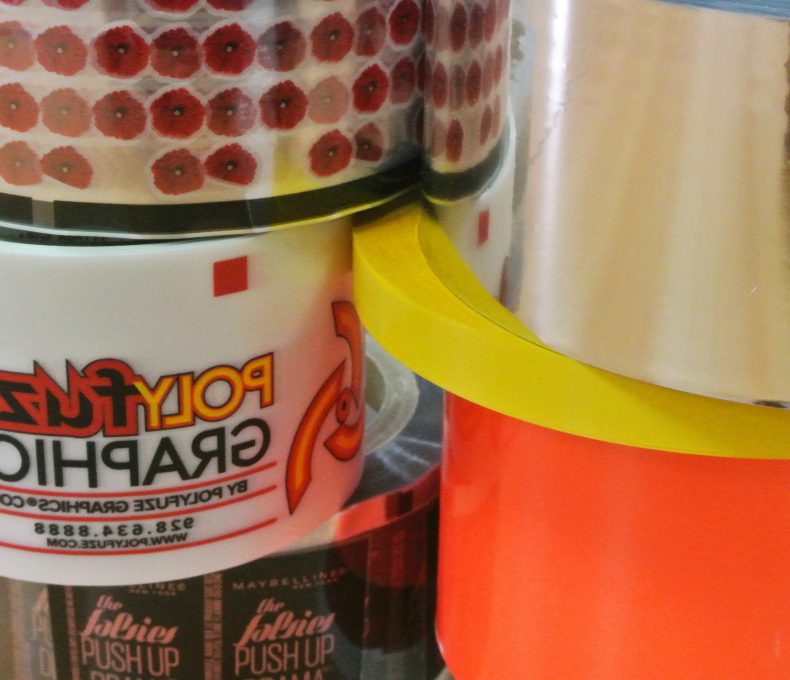Technology Comparison
Hot Stamp or Heat Transfer
The processes behind hot stamp and heat transfer decoration are very similar. Below please see a snapshot of some of the most important differences between the two techniques. Further down you will find a comprehensive list of benefits and considerations for each process.
The largest visual distinction between hot stamp and heat transfer decoration is in the number of colors used.
Multi-Color Decoration – Heat Transfer
Hot stamp typically involves using a single color foil whereas heat transfer decoration uses pre-printed foil with multi-color images also called “image foils”.
Premium Metallic Decoration – Hot Stamp
Hot stamp is superior at delivering quality decoration in metallic colors.

While hot stamp and heat transfer decoration processes are very similar, a difference can be seen in the dies used. Stamping hot stamp foils requires a die engraved with artwork. For heat transfers, only a flat plate or a silicone roller is needed.
Hot Stamp
Benefits and Considerations
| Hot Stamp Benefits | |
| Benefit | Description |
| Pigment, metallic, matte, and glossy colors | Foil is better than ink processes at delivering shiny or mirror effect finishes.
|
| Dry process |
|
| Instantaneous curing |
|
| Minimal setup time |
|
| On-demand decorating |
|
| Semi-skilled operators |
|
| Opacity |
|
| Object shape considerations | Flat or round objects are best suited for hot stamp or heat transfer, whereas objects with compound curves are not well-suited and artwork has to be adapted to the profile of the part. |
| Object surface considerations | Objects with smooth surfaces are best suited for hot stamp or heat transfer, whereas objects with textured surfaces are not.
|
| Changing artwork requires changing dies | Graphic images are achieved with Silicone or Metal Dies. A new Die is required with each change in artwork. |
| Speed of application | Dwell time requirements vary from 0.5 to 1.5 seconds in order to have a complete transfer of the image to the part |
Heat Transfer Decoration
Benefits and Considerations
| Heat Transfer Decoration Benefits | |
| Benefit | Description |
| Brilliant, multicolor graphics |
|
| Sustainable Technology (benefits dependent on particular heat transfer type selected) |
|
| Minimal setup time |
|
| On-demand decorating |
|
| Custom colors and formulations |
|
| Semi-skilled operators |
|
| Dry process | The Heat Transfer process utilizes a pre-printed/pre-manufactured graphic image on a film/carrier that is then applied with heat and pressure. No inks or solvents required at application stage thus simplifying set-up and significantly reducing change over and clean up time. |
| Instantaneous curing | As a dry process (no inks and solvents), Heat Transfer applications produce finished parts that are immediately ready to be handled and packaged without fear for damage. No post-cure or drying required. |
| Opacity |
Because Heat Transfer Labels are manufactured in layers (multiple ink passes/layers), image opacity is achieved in a single pass. This is in contrast to processes like Pad Printing where multiple hits may be required due to the thin lay down of ink. |
| Object shape considerations | Flat or round objects are best suited for heat transfer, whereas objects with compound curves are not well-suited for heat transfer (image requires adapting). |
| Object surface considerations | Objects with smooth surfaces are best suited for heat transfer, whereas objects with textured surfaces are not. |
| Changing artwork may require changing Dies | Graphic images are achieved utilizing pre-printed Heat Transfer Labels. A new Die may be required with an artwork change dependent upon graphic shape, die design, and heat or witness mark tolerance. |
| Quantities required per image | Minimum Order Quantity (MOQ) may be required.. The digital process provides variable print from label-to-label with no MOQ and a limited set-up fee. |
| Heat transfer labels provided by a vendor | Leadtimes and MOQs for Heat Transfer Labels vary dependent upon manufacturing type – Digital, Screen Printed, Gravure, Polyfuze, etc |
| Speed of application | Dwell time requirements vary from 0.5 to 1.5 seconds in order to have a complete transfer of the image to the part. |